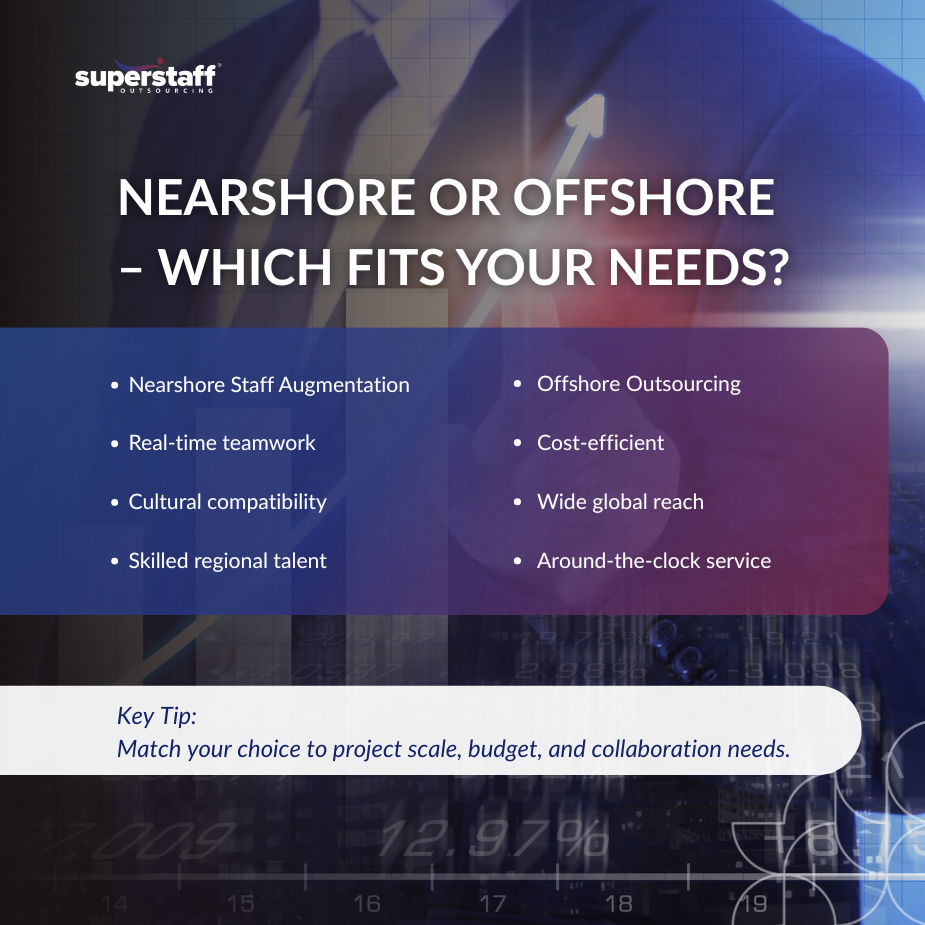
Businesses across different industries are searching for ways to expand their teams without spending heavily on in-house recruitment. One option gaining strong attention is nearshore staff augmentation, where companies work with skilled professionals in nearby countries. Colombia has become a top choice for this model because of its talent pool, cost advantages, and time zone alignment with North America.
At the same time, offshore outsourcing remains a popular approach, connecting businesses with service providers in distant countries. Each method has its strengths, but choosing between them requires a clear understanding of how they work. This guide compares nearshore staff augmentation in Colombia vs offshore outsourcing: which is better?, highlighting their benefits, differences, and considerations to help companies make the right decision.

Understanding Nearshore Staff Augmentation
Nearshore staff augmentation connects companies with professionals in nearby countries to work as an extension of their in-house team. Unlike traditional outsourcing, where an entire function is handled by an external provider, staff augmentation allows businesses to directly manage the work while benefiting from external expertise.
1. Geographic and Time Zone Advantage
Colombia’s location offers a minimal time difference with North America. This makes collaboration easier, especially for industries requiring real-time communication.
2. Direct Team Integration
Professionals hired through nearshore staff augmentation work closely with internal teams, following the same schedules, processes, and project goals.
3. Industry Specialization
From IT development to nearshore call center services, Colombia provides skilled talent across multiple sectors.
4. Cost Efficiency
While not as low as some offshore destinations, costs in Colombia are still significantly lower than hiring in the US or Canada.
5. Language and Cultural Fit
High English proficiency and cultural similarities support smoother working relationships between Colombian professionals and North American teams.
What Offshore Outsourcing Offers
Offshore outsourcing connects businesses with service providers located in distant countries, often several time zones away. This model is commonly used for large-scale operations and specialized services.
1. Large Global Talent Pool
Countries like the Philippines, India, and Eastern Europe offer a wide range of skills and large numbers of professionals for hire.
2. Lower Labor Costs
Offshore outsourcing often delivers the lowest rates, which can be a deciding factor for cost-driven projects.
3. 24/7 Operations
Time zone differences allow for continuous operations, particularly for support and customer service.
4. Specialized Capabilities
Some offshore locations are known for deep expertise in certain industries, such as software development or technical support.
5. Scalable Resources
Providers can quickly expand or reduce team sizes to match changing project needs.
Comparing Nearshore and Offshore Models
Both models provide access to skilled professionals, but the level of integration, communication, and cost varies. Understanding staff augmentation vs outsourcing is key to making the right decision.
1. Communication Speed
Nearshore teams often provide faster communication due to time zone overlap, while offshore teams may require scheduled updates to bridge time differences.
2. Cost Differences
Offshore outsourcing usually offers lower rates, but nearshore staff augmentation provides better real-time collaboration for projects requiring quick feedback.
3. Project Control
Nearshore staff augmentation gives companies more direct control over daily tasks, while offshore outsourcing often delegates full responsibility to the provider.
4. Talent Access
Offshore outsourcing offers a larger global pool, but nearshore staffing offers talent with regional expertise and cultural familiarity.
5. Collaboration Style
Nearshore staffing works well for collaborative projects, while offshore outsourcing suits tasks that can be completed with minimal supervision.
Benefits of Nearshore Staff Augmentation in Colombia
Colombia has become one of the most attractive destinations for nearshore staffing due to its workforce quality and location advantages.
1. Strong Talent in Technology and Services
Colombian professionals are skilled in software development, design, finance, and customer service.
2. Competitive Costs
Companies can reduce payroll expenses while maintaining quality standards.
3. Cultural and Language Compatibility
Shared work culture and bilingual skills make integration easier.
4. Stable Infrastructure
Reliable internet and modern office spaces support remote collaboration.
5. Government Support for Outsourcing
Policies encourage the growth of outsourcing-related industries, benefiting both providers and clients.
When Offshore Outsourcing is the Better Choice
While nearshore staff augmentation is effective, there are cases where offshore outsourcing offers more value.
1. Large-Scale Operations
If a business needs hundreds of staff quickly, offshore providers may have greater capacity.
2. Cost-Sensitive Projects
Offshore outsourcing often delivers the lowest rates available.
3. 24/7 Global Coverage
Ideal for companies that require continuous monitoring and service.
4. Established Industry Expertise
Some offshore markets have decades of experience in certain niches.
5. Broader Talent Networks
Access to specialists from multiple countries expands capabilities.
Key Considerations Before Choosing
Selecting between nearshore staff augmentation and offshore outsourcing depends on business needs, budget, and operational style.
1. Project Complexity
Projects requiring daily collaboration benefit more from nearshore staffing.
2. Budget Priorities
If cost is the top priority, offshore outsourcing may be more suitable.
3. Skill Requirements
Match the talent pool to the expertise your project demands.
4. Communication Preferences
Consider whether real-time interaction or asynchronous updates fit better.
5. Long-Term vs Short-Term Needs
Nearshore staffing often works well for long-term integration, while offshore outsourcing can fit short-term high-volume needs.
How to Select the Right Partner
Finding the right provider is essential for success in either model.
- Check the provider’s track record in your industry.
- Ask for references and case studies.
- Review their onboarding process.
- Confirm compliance with labor and data protection laws.
- Evaluate communication and reporting systems.
Building a Balanced Global Talent Strategy
Some companies use both models to balance cost savings and collaboration needs. For example, development teams may be based in Colombia for real-time work, while certain support functions are outsourced offshore for cost efficiency. This hybrid approach can offer the best of both worlds.
Smart Talent Solutions for Global Growth
Choosing between nearshore staff augmentation in Colombia vs offshore outsourcing: which is better? depends on your goals. Nearshore staff augmentation provides closer collaboration, cultural alignment, and strong integration with your in-house team. Offshore outsourcing delivers scale, cost savings, and broader global reach.
SuperStaff has experience supporting both models, helping clients build reliable teams across multiple regions. Whether you need nearshore call center services in Colombia or a fully managed offshore team, we can connect you with skilled professionals who fit your business requirements. Contact SuperStaff to explore how we can strengthen your workforce with the right outsourcing strategy.






